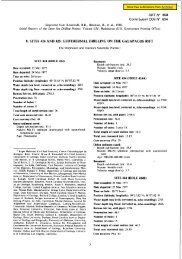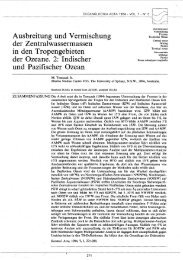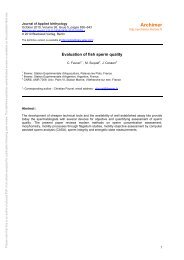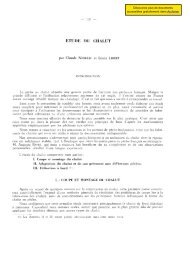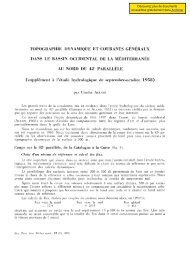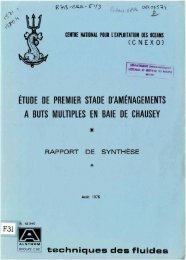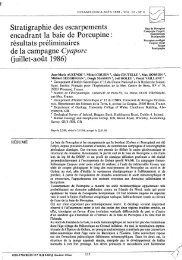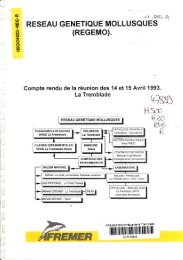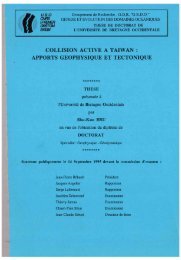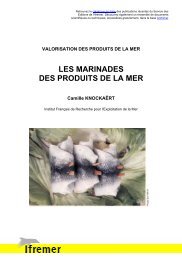Contribution à l'étude de virus de mollusques marins apparentés ...
Contribution à l'étude de virus de mollusques marins apparentés ...
Contribution à l'étude de virus de mollusques marins apparentés ...
Create successful ePaper yourself
Turn your PDF publications into a flip-book with our unique Google optimized e-Paper software.
68<br />
0.2 g/I, KCI, No. P 1300'<br />
2.77 g/I, Na,HPO" 12 H,O, No. S I 035'<br />
0.2 g/I, KH,PO" No. PI560'<br />
Distilled water.<br />
Adjust the pH to 7.4.<br />
Store aliquots at -20 oC.<br />
Culture medium:<br />
L- 15 (Leibovitz) medium, No. 074-01300'<br />
Medium 199, No. 071-01200'<br />
Basal three fold concentrated (3x) media:<br />
5 liters unit of pow<strong>de</strong>red medium L-15 or 199<br />
0.35 g/I NaHCO" No. S8875', only for 199<br />
medium<br />
2.422 gll Tris, No. T1378'<br />
Add 1.67 liter of distilled water.<br />
Adjust the pH to 7.4 with HCI, No. A420'.<br />
Sterilize by filtration through 0.22 J.1m.<br />
Store at 4 oC.<br />
Foetal calf serum (FCS):<br />
FCS, No. 011-06290'<br />
Decomplement at 56 oC for 30 min.<br />
Store 50 ml aliquots at -20 oc.<br />
Antibiotics stock solutions:<br />
Penicillin-streptomycin solution:<br />
10' Ulml, penicillin G, No. P3032'<br />
0.1 g/m l, streptomycine sulfate, No.<br />
S650l'<br />
Distilled water.<br />
Sterilize by filtration to 0.22 J.1m.<br />
Store aliquots at -20 oC.<br />
F1umequine solution:<br />
30 mg/ml, fJumequine, No. 93 128'<br />
Distilled water.<br />
Add a few drops of 5N NaOH, No. S 1225',<br />
to dissolve the pow<strong>de</strong>r.<br />
Sterilize by filtration to 0.22 J.1m.<br />
Aliquots are stored at - 20 oc.<br />
B. Disposables and inci<strong>de</strong>ntals<br />
Dissecting forceps<br />
Cell culture 25 cm' fJasks, No_ 13139'0<br />
0.22 J.1m sterile units of filtration, No.<br />
SVGVBIOlO and No. SLGV025BS"<br />
1 ml syringes , No. SPTI 12<br />
18G needles, No. AJ4012 12<br />
Scalpel bla<strong>de</strong>s, No. LBST24 12<br />
Sterile Petri dishes, No. BPS9OGEp 12<br />
24 x 36 mm glass coverslips, No. LC02436 12<br />
Homogeneizer Dounce type and piston No. A<br />
(76-152 J.1m), No. AI4.2oo.24"<br />
Sterile centrifuge tubes, No. 84207"<br />
1.5 ml microfuge tubes, No. 33605"<br />
C. Equipment<br />
Cell culture incubator"<br />
Cell culture hood'6<br />
Centrifuge type j-6M1E"<br />
Microfuge type 12"<br />
Inverted microscope<br />
Transmission election microscope JEM 1200<br />
EX"<br />
126<br />
D. Animais and sea water<br />
Pacific oysters, Crassos/rea gigas, were reared in<br />
the Marennes-Oléron basin, France.<br />
Sea water was pumped in the Marennes-Oléron<br />
basin.<br />
3_ Procedures<br />
A. Preparation of oyster hemolymph and media<br />
1. Crassas/rea gigas hemolymph (CGH)<br />
a) Open carefully the oyster without damaging<br />
the pericardic membrane.<br />
b) Discard sea water and dry the animal with<br />
a sheet of paper.<br />
c) Immediately puncture slowly the hemo<br />
Iymph in the pericardic cavity. 0.5 to<br />
2 ml hemolymph are expected for each<br />
oyster.<br />
d) Pellet the haemocytes (2500 rpm, 10 min.,<br />
4 OC) and filter the cell free hemolymph<br />
through a sterile 0.22 J.1m unit.<br />
e) Store at 4 oC and use before two weeks.<br />
Do not freeze.<br />
2. Culture medium<br />
Improvement of the medium:<br />
a) L- 15 (3x) and 199 (3x) media and sea<br />
water supplemented with 10% FCS.<br />
b) L-15 (3x) mixed with sea water to<br />
different ratio (4: 1,3:2,2:3 and 1:4) and<br />
supplemented with 10% FCS.<br />
c) L-15 (3x) and sea water to a ratio of 1:1,<br />
supplemented with 0, l, 5 or 10% FCS ,<br />
and 0, l, 5, or 10% CGH.<br />
Optimized medium:<br />
L- 15 (3x) and sea water to a ratio of 1: l ,<br />
further supplemented with 10% FCS and<br />
5% CGH.<br />
Add 1: 1 000 penicillin-streptomycin and<br />
fJumequine solutions to ail these media.<br />
B. Preparation of culture surfaces<br />
1. Cover the surface of a 25 cm' plastic cu lture<br />
fJask with 5 ml of 0.1 mg/ml poly-D<br />
Iysin, then incubate at room temperature for<br />
5 min. .<br />
2. Rinse twice with 5 ml sterile distilled water<br />
and allow to air dry.<br />
3. Poly-D-Iysin coated fJasks could be stored at<br />
4 oC, but were used before two weeks.<br />
C. Decontamination of oysters<br />
1. Wash and brush the shells un<strong>de</strong>r tap water,<br />
then bath the oysters in 70% ethanol for<br />
30 sec, and let them dry un<strong>de</strong>r a sterile<br />
hood.<br />
2. Carefully open the oysters without damaging<br />
the pericardic membrane.<br />
3. Wash the animaIs and the inner shells with<br />
sea water-lween, rinse with autoclaved sea<br />
water.



